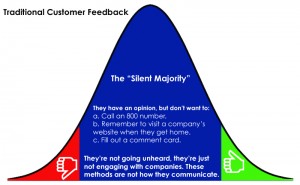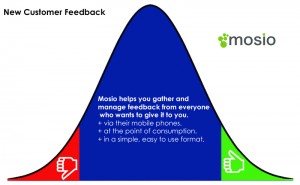
Augmenting Toll Free 800 Numbers With Mobile Text Messaging for Customer Service
Americans are texting more than they’re talking, a trend that’s likely to grow more than slow down over the next 5-10 years. It’s easy and it’s quick. The popularity and usage of texting is no surprise as the on-the-go lifestyle ends up being more like living than a style type. The truth is, people are still going to use the phone to talk, but the growing usage of text messaging across all demographics shows more people prefer text messaging.
Customers Will Be Heard
The bell curve above illustrates how customer feedback has traditionally been given: in person, comment card, telephone and email. It used to be an extremely effective way to give feedback to a company. But with the growth of social media, customers are being heard by their friends, co-workers and strangers whether they are happy or unhappy with a product or service. Some companies have taken to Twitter to handle customer service issues, but “we’re on Twitter” is not a social media customer service strategy (and it’s certainly not a mobile customer service strategy).
I’m not suggesting companies using Twitter don’t continue to do so, but reacting to a tweet about a bad experience is like someone yelling “this food sucks!” in a crowded restaurant: you can run over and help your upset patron, but the damage has been done. That’s the obvious reason why so many companies are jumping into the social media space: they have to do so to protect their brand image. But there’s another way to protect one’s brand image: make yourself more available to communicate directly with your customers.

Text Messages: Direct Customer Conversations
If people are texting twice as much as they are talking and they’re using text messaging and mobile apps on their phones to update their status and communicate with friends, companies need to make themselves available via the mobile channel. People are posting their loves and dislikes for a product or service on social media services because it’s easy to do so. Integrating text messaging gives companies an opportunity to start a customer conversation using the medium customers prefer and keep the conversation between them. Is it going to stop everyone from ranting on updates and blogs when they’re upset? No, but it opens up dialogue with more possible customers at a fraction of the cost of 800 tolls or chasing down posts online.
Text Messaging Beyond Customer Service: Direct Response in Marketing and Advertising
I hate the word “blast” when it comes to mobile marketing and it’s a word used far too often in our industry. Customers don’t want to be blasted on their mobile phones. In fact, it’s the last place they’d want to be communicated with in such a way. The mobile medium offers so much to traditional advertising with more and more research showing mobile getting better response rates than online advertising.
We soft launched a mobile advertising response product with a few marketing and advertising agencies and are getting great feedback. The system lets customers help themselves get more information immediately using their mobile devices. Text messaging as a method of responding to ads, whether they be print, TV, billboards, posters or flyers is going to be a huge hit in 2010 and beyond. Used in customer service, direct response or as a helpline for a brand, mobile text messaging is still in its infancy. What’s better, you don’t need “an app for that” to use it in your business.
For information on how Mosio can help you set up mobile text messaging customer satisfaction, service and feedback systems,contact us or visit www.mosio.com.
One of my favorite customer service quotes is “Customer service is not a department, it’s an attitude!” -UNKNOWN
Hmm, good analysis on experiential text message marketing. I agree people don’t like to be blasted, but what do you think will be implemented in the mobile future?